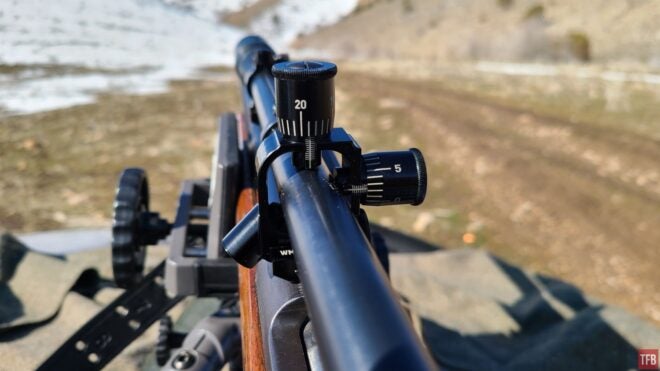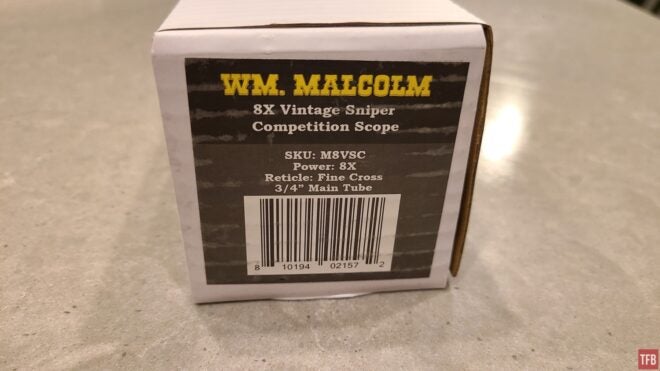Hi-Lux Optics offers a full range of optics for firearms, including a large selection of reproduction scopes for vintage rifles in their Malcolm lineup. One of the most interesting is the USMC 8x Gen II which is a modern take on the classic Unertl target scope. Let’s see how this revival of a legend performs.
More Optics Articles @ TFB:
- TFB Review: Leupold MK5HD 5-25×56 FFP Scope
- New Strike Eagle 3-18×44 FFP Scope from Vortex Optics
- NEW Primary Arms 3-18×44 & 4.5-27×56 FFP GLx Rifle Scopes Ready For Pre-Order
- TFB Review: Pulsar Thermion 2 LRF XP50 Pro Thermal Riflescope
- [SHOT 2023] New Arken EPL Long Range Hunting Scopes
Disclosures are important in any review. Hi-Lux provided this optic for review. I purchased the mounting blocks and paid for the ammunition. No money changed hands. I don’t have a relationship with the company other than visiting their booth at SHOT Show 2023.
The Rifle
The USMC 8x is primarily intended for clones of the World War II M1903A1 sniper rifle fielded by Marine snipers. It is specifically marketed to competitors who shoot vintage sniper matches. However, there is another classic USMC sniper rifle that saw action with a Unertl 8x: the Winchester Model 70 in Vietnam. Carlos Hathcock and his fellow snipers of that era used various Model 70 rifles, generally with Unertl scopes (or similar) mounted to heavy target barrels.
I had the opportunity to buy a similar Model 70 a few years back and I jumped at the chance. This rifle had a rough life and was of little collector value, but still could be a fun shooter. The original heavy barrel had been somewhat sloppily fluted, and the barrel was rechambered from .30-06 to .300 Win Mag. These modifications were made back when this was just a rifle rather than a collectible, but it still hurts to think about what this rifle could have been in its original condition.
In order to not pummel the USMC 8x scope unfairly, I worked up a .300 Win Mag load that mimics the performance of the .30-06 M72 Match load. The M72 pushed a 173-grain boat tail bullet at 2,650 FPS. I more or less duplicated that by using a 175-grain Sierra MatchKing and Winchester 748 powder based on information in old Lyman Cast Bullet reloading manuals. It averages just over 1 MOA in this rifle and is more than adequate for my purposes.

Setup
The USMC 8X uses a vintage mounting system. Rather than the ubiquitous Picatinny rail, it uses old-school mounting blocks on the receiver and barrel. Those blocks have a dovetail cut with a small cutout used by Unertl or Lyman scopes. My rifle did not have those blocks. The USMC 8X includes the appropriate blocks for the M1903A1. One of those blocks fit on the receiver, but I still needed a block for the barrel. Rather than tracking down an (expensive) original, I went with a reproduction from Steve Earle Products. Their ordering process is a blast from the past but the block arrived quickly and fit perfectly. However, my math was wrong and I ended up needing a lower block for the receiver than what was included with the scope. Thankfully, I was able to source the necessary rear block from Freeland’s Sports.
With the blocks secured to the rifle, the scope mounted easily. It slides onto the dovetail portion. Each mounting ring has a thumbscrew that tightens around the small cutout in the block. Once the rings are secured in place, the scope is free to slide forward and aft. Allowing the scope to slide during recoil reduced the amount of shock imparted under recoil. This was necessary back when Unertl-style scopes were common, but it is a charming anachronism today.
Zeroing
While the scope may slide in its mounts, zeroing works the same as a modern scope. Boresighting helps get the shots on paper. Elevation and windage are dialed on the appropriate turrets, and inputs track consistently. The spacing of the scope mounting blocks dictates the click graduation; further apart makes smaller adjustments per click, and closer together results in more coarse adjustments. The block spacing on this setup works out to 1/4 MOA, which is very convenient. The turrets can also be reset to zero.

Counting revolutions works differently than modern scopes. There is not a true zero stop. However, there are markings along the adjusters that can show how many revolutions are dialed in. This works something like the windage adjustments on an M-16A2 rear sight.
One other unique feature is the ability to rotate the reticle in the tube. This is not a factor in modern optics with Picatinny rail mounting. But with two little blocks several inches apart as mounts (and a tube that slides in its rings), this does not always result in a perfectly-level reticle. Simply loosen the two small screws in the reticle adjustment ring and turn it to level.

On The Range
Shooting with the USMC 8X is the most fun I have had with a gun in recent years. In lieu of the Christmas tree or Horus reticles that now dominate the long-range shooting scene, it has a simple crosshair. Adjustments can be dialed in as on a traditional target scope.
The heart of the scope is a 3/4-inch main tube. In a world of 34- and 35-mm scope tubes it is a real change. As scopes tubes have added girth, many have also tried to shorten the overall length. The USMC 8X is twenty-three inches long. In almost every quantifiable way, this scope is the opposite of the modern era. But that is also its charm. It is not trying to win the NGSW optics contract or to dominate the duty-grade scope market. In its soul, the USMC 8X is a fun scope rather than a serious tool for backcountry hunters or police snipers.

However, it does embrace some modern comforts. One fortunate difference from the vintage Unertls is the glass quality. Many of those scopes are pushing 80-100 years old, and the quality of the average lens has come a long way in that time. The image is as bright and clear as can be accomplished within the limitations of the scope’s external dimensions. I would not say the image quality rivals current high-end glass, but it is an upgrade from the original models I have looked through.
The turrets also deserve praise. The clicks are solid, and the tracking is consistent insofar as I can quantify. Now, I am not saying the turrets are better than Nightforce or anything like that. But they do seem like the ultimate evolution of what this style of turrets can be when modern materials and manufacturing are used. Hi-Lux calls this specific scope the Gen II model because it has improved turrets over their original model. I have not used the Gen I version, so I cannot share any first-hand opinions on them, but a lot of thought and effort went into the creation of the Gen II turrets and it shows.

On a few occasions, I found myself wondering why the eye relief seemed so poor. After each shot, I would then remember that I had to pull the scope back to its pre-recoil position. That became easier to remember with practice but will always feel odd to someone who is used to first focal plane scopes with milliradian adjustments and illuminated reticles.

Conclusion
If you have a gun that needs a scope like this, there are two choices. You can buy an original Lyman or Unertl and have the most historically-accurate setup, or opt for the Hi-Lux and optimize performance while keeping the vibes of the vintage optics. I would choose the Hi-Lux every time because I want a shooter rather than a display or collector piece. I want something that I can shoot and enjoy in the field without that nagging worry that every range trip might be the one where a scope the age of my grandparents finally gives up.
Whether it’s a White Feather clone or a 1903A1 Springfield rifle for vintage sniper competitions, the USMC 8x is a great choice for a rifle that will be shot. It is not trying to compete with the current generation of optics but it does blend the style and feel of scopes from another era with modern glass and consistent turrets. And to me, that is the best of both worlds.
We are committed to finding, researching, and recommending the best products. We earn commissions from purchases you make using the retail links in our product reviews. Learn more about how this works.
 Your Privacy Choices
Your Privacy Choices

